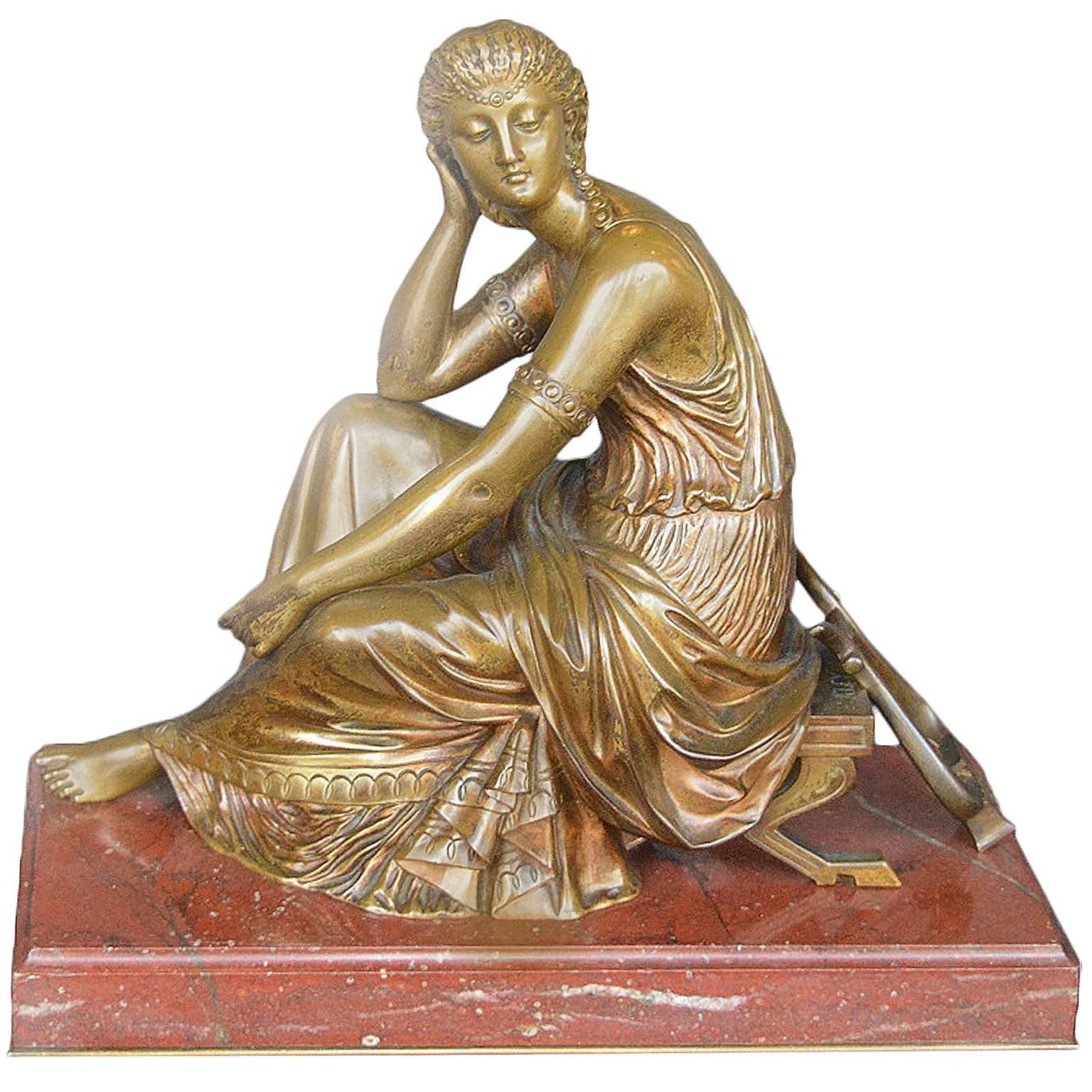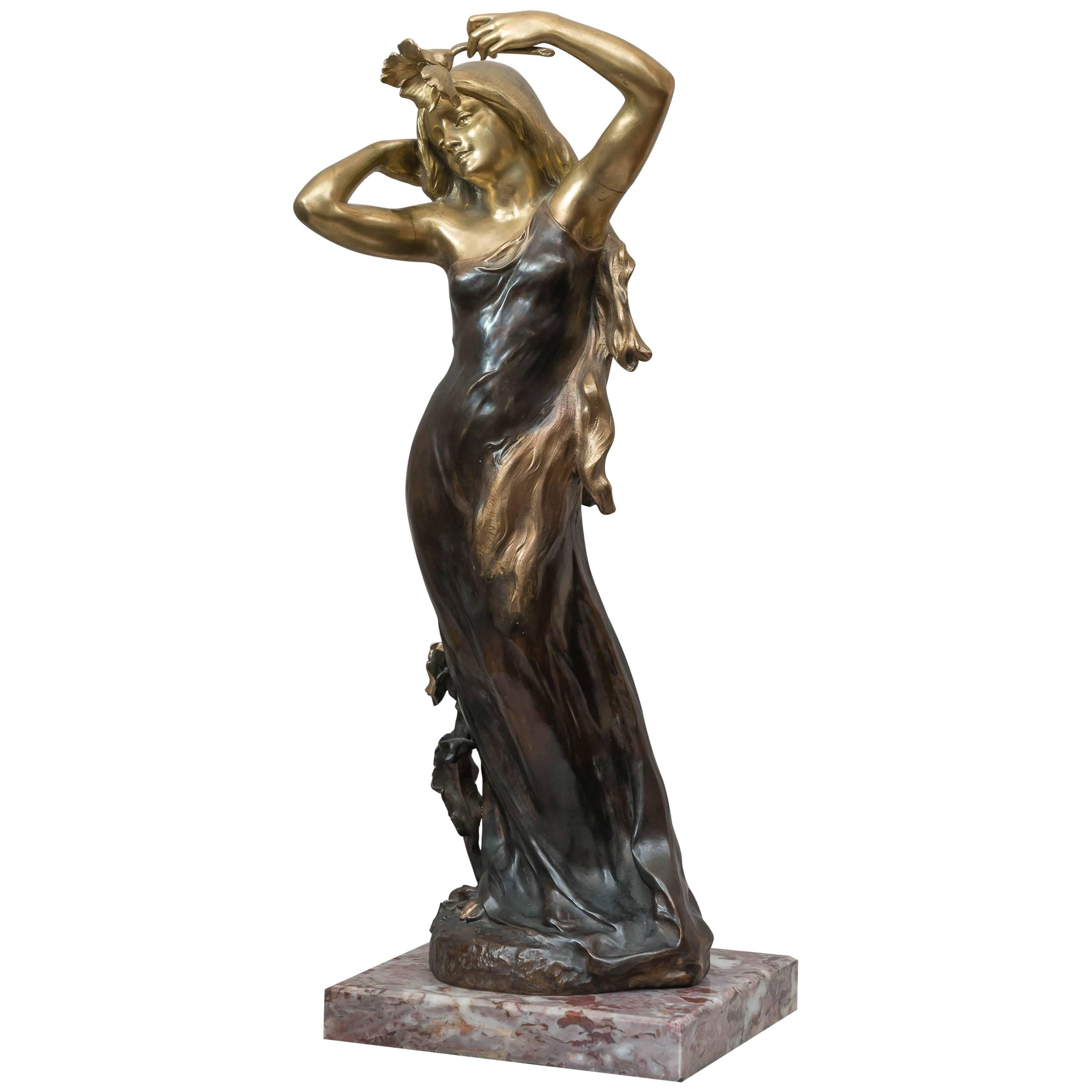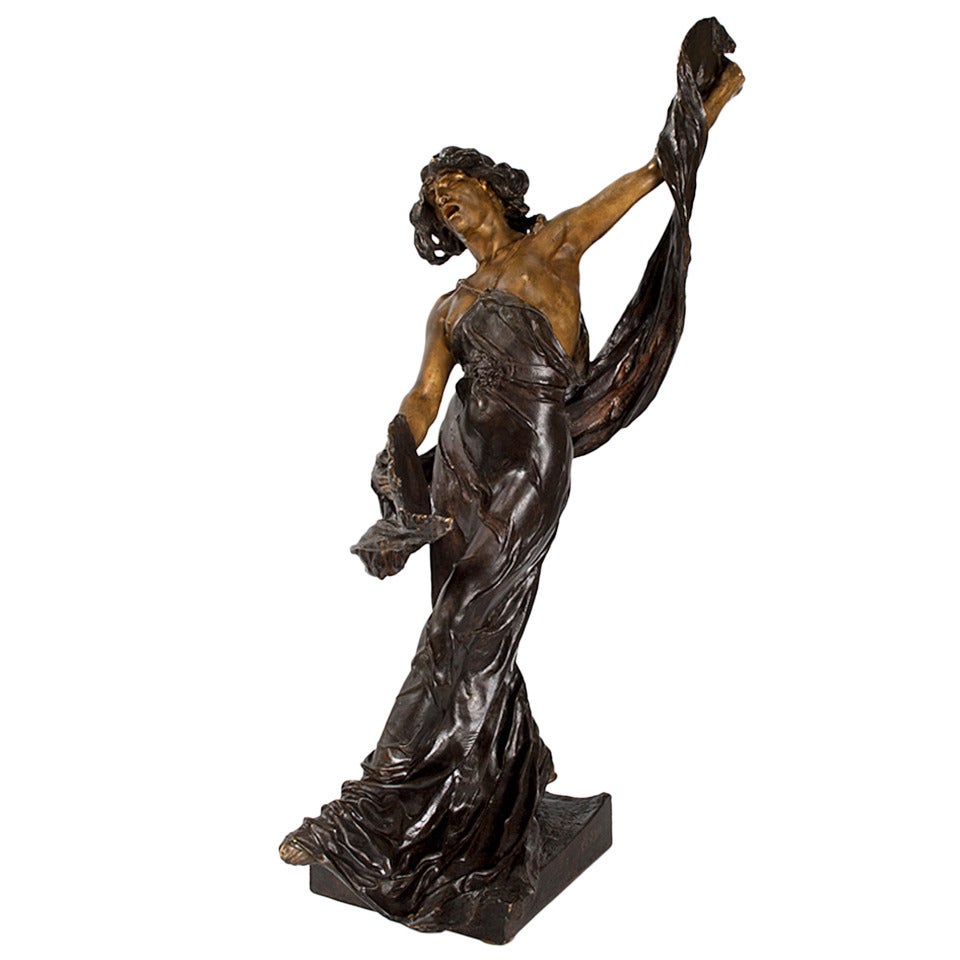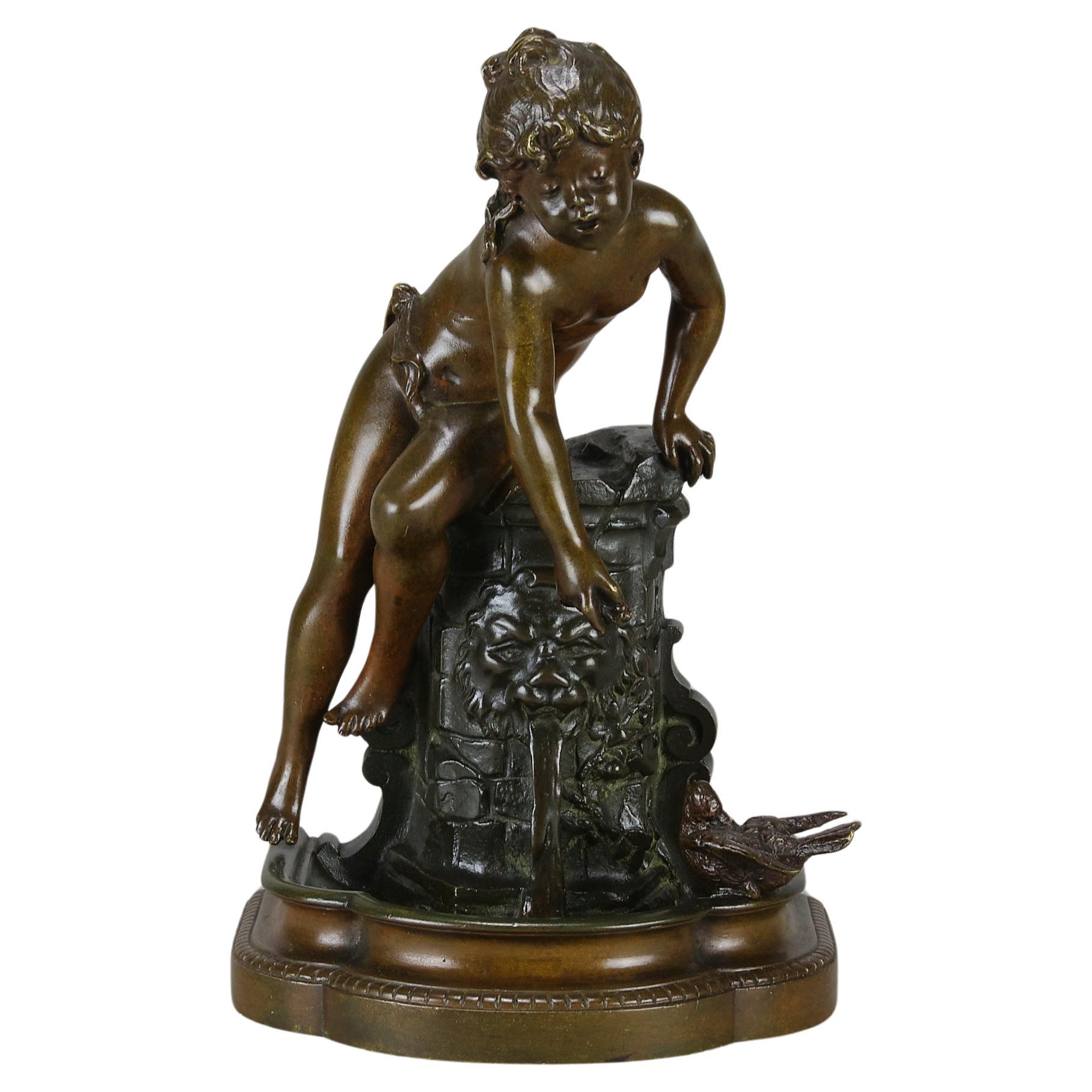Items Similar to An Art Nouveau Bronze Figural Ewer by Auguste Ledru
Want more images or videos?
Request additional images or videos from the seller
1 of 9
An Art Nouveau Bronze Figural Ewer by Auguste Ledru
About the Item
An Art Nouveau Bronze Figural Ewer Modelled With A Water Nymph by Auguste Ledru, Cast by Susse Frères.
Inscribed 'Susse F. Paris Edt.', stamped also to the underside and dated 1895.
This impressive ewer is of patinated bronze, with marine and erotic imagery, cast and applied in high relief. A fully modelled female figure of a water nymph reclines on the shoulder of the ewer surrounded by swirling waters. The rim and spout of the ewer is cast with a mask of Neptune.
Auguste Ledru (1860-1902) was a pupil of Dumont, Bonnassieux, Thomas and Boisseaux and made his debut at the Salon of 1883. Although trained as a monumental sculptor he devoted most of his work to the decorative arts creating small items often of sensual design incorporating nudes, nymphs and natural forms.
Tracing its origins to 1758, the Paris foundry of Susse Frères is one of the oldest art foundries in Europe. They were appointed suppliers to Empress Marie Louise from 1812 and the Duc de Berry from 1818. Following the 1830 revolution they were granted a Royal Warrant as an official supplier to the monarchy. Originally a stationery company selling small bronze statuettes, the company began to focus on the process of bronze casting as early as 1839 under the direction of the brothers Michel Victor and Amedee Susse. They producing in that year a six-page catalogue of bronze sculpture.
In 1847 they obtained the right to use the Sauvage procedure for reduction, similar to that invented by Achille Collas and employed by Ferdinand Barbedienne. The ability to produce reductions of large scale bronzes enabled Susse to create editions of work in various sizes and opened up the market to collectors. Michel Victor Susse died in 1860 leaving Amedee as the sole director of the foundry until 1880 when Albert Susse became the director.
In the subsequent years Susse Frères obtained the rights to produce editions of the works of some of the most important French sculptors of the nineteenth century including: James Pradier, Pierre-Jules Mêne , Auguste Cain , Pierre-Nicolas Turgenev , Yevgeny Alexandrovich Lanceray, Louis-Ernest Barrias , Jules Dalou , Alexandre Falguière and Mathurin Moreau.
Renowned for the quality of its casting and multipatinated finishes, the firm of Susse Frères exhibited with notable success at many of the great exhibitions of the nineteenth century including a prize medal at the 1851 Great Exhibition in London and a Grand Prix at the 1905 Lieges Exposition Universelle.
Paris, Dated 1895.
Literature:
Cadet, Pierre. Susse Frères 150 Years of Sculpture, Susse Frères, (Paris), 1992; p.206 ill.
- Creator:Auguste Ledru (Sculptor)
- Dimensions:Height: 14.18 in (36 cm)Width: 11.82 in (30 cm)Depth: 10.24 in (26 cm)
- Style:Art Nouveau (Of the Period)
- Materials and Techniques:Bronze,Patinated
- Place of Origin:
- Period:
- Date of Manufacture:Dated 1895
- Condition:Wear consistent with age and use.
- Seller Location:Brighton, GB
- Reference Number:
About the Seller
5.0
Recognized Seller
These prestigious sellers are industry leaders and represent the highest echelon for item quality and design.
Platinum Seller
These expertly vetted sellers are 1stDibs' most experienced sellers and are rated highest by our customers.
Established in 1964
1stDibs seller since 2014
48 sales on 1stDibs
Typical response time: 1 hour
Associations
The British Antique Dealers' AssociationLAPADA - The Association of Arts & Antiques Dealers
- ShippingRetrieving quote...Ships From: Brighton, United Kingdom
- Return PolicyA return for this item may be initiated within 7 days of delivery.
More From This SellerView All
- 'The Juggler', an Art Deco Bronze Figure, by Claire J. R. Colinet, circa 1925By Claire Jeanne Roberte ColinetLocated in Brighton, West Sussex'The Juggler' - A fine Art Deco silvered bronze figure, by Claire J. R. Colinet. French, circa 1925. Engraved to base 'CL J.R. Colinet'. This dramatic and large silvered b...Category
Early 20th Century French Art Deco Figurative Sculptures
MaterialsBronze
- 'Cupid & Psyche' an Important Bronze Figure by François-Raoul LarcheBy François-Raoul LarcheLocated in Brighton, West Sussex'Cupid & Psyche' - An important parcel-gilt and patinated bronze figure, by François-Raoul Larche. Signed to the base 'Raoul Larche 1891'. This finely cast parcel-gilt bronze figure depicts Cupid and Psyche with Zephyr. François-Raoul Larche (1860-1912), the son of an ornamental sculptor, was a well-known Art Nouveau sculptor...Category
Antique 19th Century French Figurative Sculptures
MaterialsBronze
- Large Multi-Patinated Bronze Figure of an Arab Warrior by Henri-Honoré PléBy Henri Honoré PléLocated in Brighton, West SussexA Large and Important Multi-Patinated Bronze Figure of an Arab Warrior by Henri Honoré Plé. Signed Henri Plé to the base. The figure is finely modelled as an Arab warrior, with sw...Category
Antique 19th Century French Figurative Sculptures
MaterialsBronze
- An Orientalist Lifesize Figural Bronze Statue, Attributed to Louis HottotBy Louis HottotLocated in Brighton, West SussexAn Orientalist Lifesize Figural Bronze Statue, Attributed to Louis Hottot (French, 1834-1906). Modelled as a lady in Ottoman dress standing beneath an Eastern style pagoda with mina...Category
Antique 19th Century French Figurative Sculptures
MaterialsBronze
- ‘Gloria Victis’, A Patinated Bronze Figural Group by Mercié, Cast by BarbedienneBy Ferdinand BarbedienneLocated in Brighton, West SussexA Patinated Bronze Figural Group of ‘Gloria Victis’ (‘Glory to the Vanquished’), Cast by Ferdinand Barbedienne from the Model by Marius-Jean-Antonin Mercié (French, 1845-1916). ‘Gloria Victis’ (‘Glory to the Vanquished’). Bronze, gilt and dark brown patina. Signed 'A. Mercié', with foundry inscription 'F. BARBEDIENNE, Fondeur. Paris.' and A. Collas reduction cachet. The integral base titled 'GLORIA VICTIS'. This cast is part of a limited edition by the Barbedienne Foundry. France. Circa 1880. ‘Gloria Victis’ is one of the most recognisable and important works of sculpture of the nineteenth century and a definitive image of France’s historic national identity. The figure of glory, winged and wearing armour, carries a dying young warrior heavenwards towards fame and immortality. The compositional daring of the group must be admired for balancing two figures on the minimal support of one foot, wings spread in the moment before taking flight. Mercié was a student at the French Academy of Rome when the Prussians invaded France in 1870. Shortly after the war had begun, he executed a group depicting the figure of Fame supporting a victorious soldier. When news reached Mercié in Rome that the French had surrendered, he decided to alter his group, replacing the victorious soldier with a defeated casualty, thus transforming an allegory of ‘Glory to the Victors’ into one of ‘Glory to the Vanquished’. Completed in 1872, a year after the defeat of French soldiers against the Prussian army, the statue personifies a defeated but heroic France. The title is also a reversal of the famous formula, ‘Vae Victis’ (Death to the Vanquished), which the Gallic general Brennus exclaimed upon defeating the Romans in 390 BC. The figure of the fallen soldier was thought to represent Henri Regnault, a fellow sculptor of Mercié who was killed on the last day of fighting. Measuring 317 cm. high the original group of ‘Gloria Victis’ was unveiled in plaster at the Salon of 1872. It was bought by the City of Paris for the sum of twelve thousand francs and then cast in bronze by Victor Thiébaut for eight thousand five hundred francs. The bronze was exhibited at the Salon in 1875 and first placed in Montholon Square in the 8th arrondissement. In 1884 it was transferred to the courtyard of the Hôtel de Ville and in 1930, it entered the collection of the Musée du Petit Palais, where it can be seen to this day. The Thiébaut Frères foundry also cast Gloria Victis bronzes for the cities of Niort (requested 1881) Bordeaux (requested 1883), Châlons-sur-Marne (today, Châlons-en-Champagne; requested 1890), and Cholet (requested 1901). In 1905, the Danish brewer and art collector Carl Jacobsen was permitted to have an exact cast made of the original sculpture in Paris, on condition that the base was made 2 cm lower and bore the inscription “Original tilhører Paris By” (The original belongs to the City of Paris). It too was cast by the Thiébaut Frères foundry. Gloria Victis was one of Jacobsen’s most important and his last acquisition. Today it has been returned to its original position in the Winter Garden at Glyptoteket, Copenhagen, Denmark. The full-size plaster was shown again at the Paris Expositon universelle of 1878 alongside a bronze reduction by Barbedienne. By this time Antonin Mercié had entered into a commercial edition contract with the Ferdinand Babedienne foundry to produce bronze reductions of Gloria Victis, his most famous work. Gloria Victis is first recorded to have been produced in three sizes and by 1886 Barbedienne’s ‘Catalogue des Bronzes D’Art’ lists six sizes measuring 3/5, 9/20, 7/20, 3/10, 6/25 and 2/10, of the original. These reductions were produced by an invention of Barbedienne’s business partner Achille Collas. The Collas reducing machine was a type of complex mechanical pantograph lathe that enabled sculpture to be mathematically measured and transcribed to scale, in the round, thus making a reduced size plaster from which a bronze could be cast. Mercié's modern sculpture had become an instant classic, even receiving an entry in the Nouveau Larousse Illustré. The success of the group undoubtedly lay in the fact that it was admired not just on an aesthetic level, but also on a patriotic level, particularly in its commemoration of heroism in defeat. Immediately ‘Gloria Victis’ was recognised as a national artwork, capable of arousing patriotism and casts were ordered from Barbedienne as local memorials commemorating the war’s dead for cities across France. ‘Gloria Victis’ was considered so much a part of France’s national identity that for the 1900 Paris Exhibition, Ferdinand Barbedienne’s nephew Gustave Leblanc, loaned a bronze example to feature as part of l’Exposition centennale de l’art français. Literature: For an interesting account of the process of creating a reduction in bronze of the Gloria Victis by Barbedienne and illustrations of the casting and finishing of the bronze see: 'Ferdinand Barbedienne': Theodore Child; Harper's new monthly magazine, Volume 73, Issue 436, September 1886. ‘Contemporary French Sculptors’: The Century, Volume 33, Issue 3, Jan 1887. ‘Modern French Sculpture’: Harper's new monthly magazine, Volume 76, Issue 452, January 1888. S, Lami, ‘Dictionnaire des sculpteurs de l'Ecole française au dix-neuvième siècle’, Tome III. G.-M., Paris, 1914, p. 432. Peter Fusco and H.W. Janson, The Romantics to Rodin: French Nineteenth Century Sculpture from North...Category
Antique 19th Century French Figurative Sculptures
MaterialsBronze
- 'Bonne Année, Bonne Santé', a Bronze Figure by Adolphe Maubach, circa 1900By Adolph MaubachLocated in Brighton, West Sussex'Bonne Année, Bonne Santé' -A fine patinated bronze figure by Adolphe Maubach. French, circa 1900. Signed 'Adolphe Maurbach' and bearing a gilt-bronze title plaque 'Bonne Anné...Category
Antique Late 19th Century French Figurative Sculptures
MaterialsBronze
You May Also Like
- French Bronze Art Nouveau Classical Figural Women by L. KleyBy Louis KleyLocated in Los Angeles, CA19th century French bronze Art Nouveau classical figural woman.Category
Antique Late 19th Century French Art Nouveau Figurative Sculptures
MaterialsBronze
- Art Nouveau Bronze Figure of a Young WomanBy Henryk Kossowski Jr. 1Located in Petaluma, CAFor the art nouveau lover, this is certainly worth one to ponder, for all others, here is fine example art nouveau. The two color patina makes this very desirable. Her beautiful gold...Category
Antique 1890s French Art Nouveau Figurative Sculptures
MaterialsMarble, Bronze
- Ségoffin Art Nouveau Patinated Bronze Figural SculptureBy Victor SegoffinLocated in New York, NYA French Art Nouveau patinated bronze figural sculpture, depicting a dancer with scarves and cymbals by Victor Ségoffin (1867-1925). Born in Toulouse, educated at Ecole nationale su...Category
Early 20th Century French Art Nouveau Sculptures
MaterialsBronze
- 19th Century Art Nouveau Bronze Sculpture "Fille au Puits" by Auguste MoreauBy Auguste MoreauLocated in London, GBA very fine late 19th Century Art Nouveau bronze figure of a young girl sat upon a well feeding a small bird, exhibting excellent rich brown variegated patina and very fine hand fini...Category
Antique Late 19th Century French Art Nouveau Figurative Sculptures
MaterialsBronze
- 'L'Echo' An Art Nouveau bronze sculpture by Mathurin MoreauBy Mathurin MoreauLocated in Forest Row, East Sussex'L'Echo' an Art Nouveau bronze sculpture by Mathurin Moreau. A deep brown late 19th century bronze sculpture by Mathurin Moreau depicting a young maiden holding her hand up to her ea...Category
Antique 1880s French Art Nouveau Figurative Sculptures
MaterialsBronze
- Art Nouveau French Bronze with Enamel Paint Child Sculpture by Auguste MoreauBy Auguste MoreauLocated in San Diego, CABeautiful Art Nouveau bronze sculpture by French artist Auguste Moreno. The sculpture is made of bronze with enamel painted accents. Signed on the back. Attached to a marble base. In...Category
Early 20th Century French Figurative Sculptures
MaterialsBronze
Recently Viewed
View AllMore Ways To Browse
Statuette 19th Century
Auguste Nicolas Cain
Nautical Sea Chest
Oku Oval
Orley Shabahang Labyrinth
Shagreen Wallpaper
Tall Vintage Orange Lampshade
Thomasville Oak Dining Chairs
Tri Light Desk Lamp
Vintage Plaster Relief Plaque
Wall Mount Mailboxes
Warhol Basquiat Press Photo
18th C Italian Fauteuils Chairs
18th Century Italian Venetian Open Arm Chairs
2 Arm Candelabra Gilt Bronze Louis Xv
Alessio Tasca Gres
Antique Bird Napkin Rings
Antique Five Legged French Chairs





